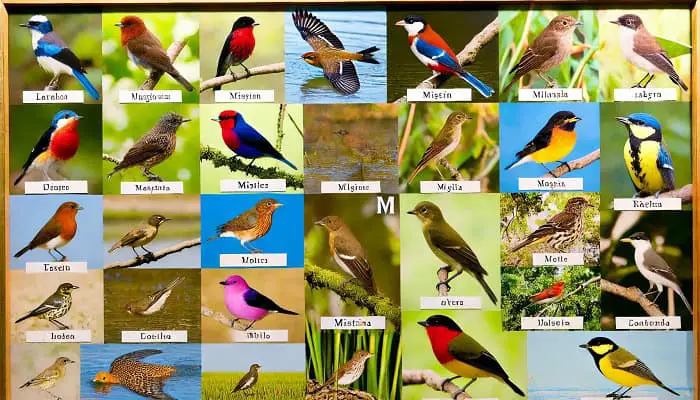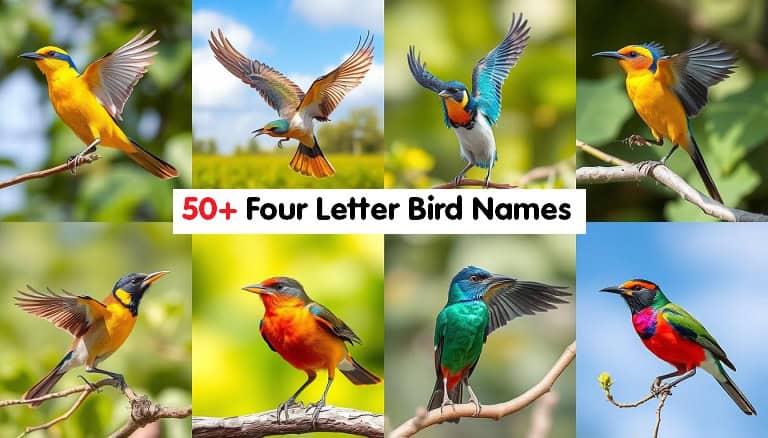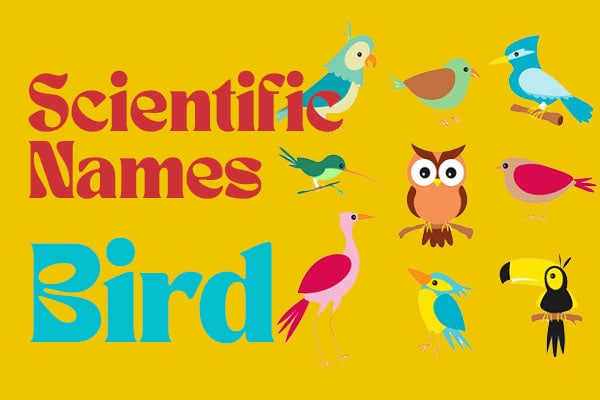17 Birds That Start with Letter M (Including Photos)
Birds are fascinating creatures that come in all shapes, sizes, and colors. Among the countless birds have names that start with letter ‘M’. This article explores various birds, beginning with “M,” highlighting their unique characteristics, habitats, diets, and more. From the colorful Macaw to the melodious Mockingbird, each bird has its own story to tell.
1. Magpie (Pica pica)
- Size: 16-24 inches (40-61 cm)
- Weight: 6.5-8.5 oz (180-240 g)
- Lifespan: 3-5 years in the wild
- Diet: Omnivorous; insects, small mammals, fruits, and garbage
Magpies are intelligent birds known for their striking black and white plumage. They are often seen hopping around parks and gardens, searching for food. These birds are social and can often be found in groups. Magpies are known for their curiosity and playful behavior, making them a favorite among birdwatchers.

Magpies are also famous for their ability to mimic sounds, including human voices and other birds. They build large nests in trees, which they line with soft materials. Their omnivorous diet allows them to adapt to various environments, making them a common sight in many regions.
2. Macaw (Ara spp.)
- Size: 20-40 inches (51-102 cm)
- Weight: 1-3.5 lbs (0.5-1.6 kg)
- Lifespan: 30-50 years in the wild (up to 80 in captivity)
- Diet: Fruits, nuts, seeds, and flowers
Macaws are large, colorful parrots native to Central and South America. They are easily recognizable due to their vibrant feathers, which can be blue, red, green, or a mix of colors. Macaws are social birds that often live in flocks and are known for their playful personalities.
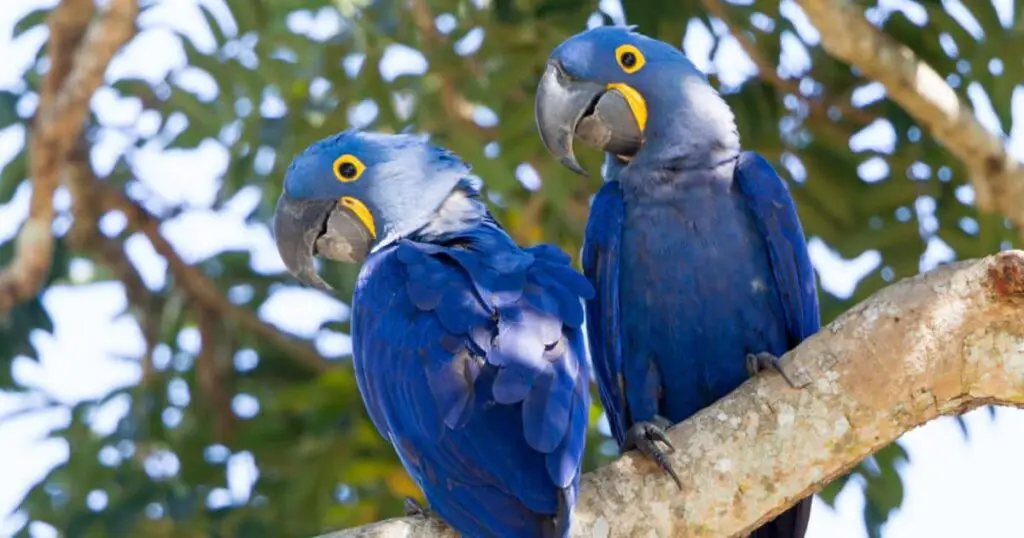
These birds have strong beaks that can crack open tough nuts and seeds. In the wild, they spend much time in trees, foraging for food and socializing. Macaws are intelligent and can learn to mimic human speech, making them popular pets, though they require much care and attention.
3. Meadowlark (Sturnella spp.)
- Size: 8-10 inches (20-25 cm)
- Weight: 3.5-5.5 oz (100-155 g)
- Lifespan: 4-7 years in the wild
- Diet: Insects, seeds, and grasses
Meadowlarks are known for their beautiful songs and striking yellow bellies. They are often found in open fields and grasslands, where they sing from tall grasses or fence posts. Their melodic calls are a hallmark of summer in many areas.
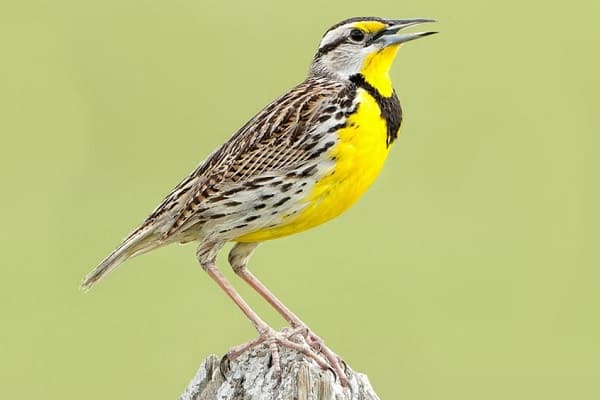
These birds are ground foragers, searching for insects and seeds. They build their nests on the ground, making them vulnerable to predators, but their camouflage helps protect them. Meadowlarks are an important part of the grassland ecosystem, helping to control insect populations.
4. Merganser (Mergus spp.)
- Size: 20-28 inches (51-71 cm)
- Weight: 1.5-3.5 lbs (0.7-1.6 kg)
- Lifespan: 5-10 years in the wild
- Diet: Fish, crustaceans, and aquatic invertebrates
Mergansers are a type of diving duck known for their slender bodies and long, pointed bills. These birds are excellent swimmers and are often found in lakes and rivers, where they dive underwater to catch fish and other prey. Their unique adaptations make them skilled hunters.
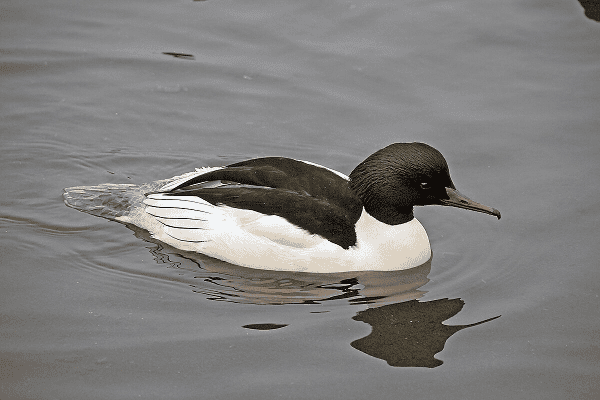
Mergansers have serrated edges on their bills, which help them grip slippery fish. They often hunt in small groups, using teamwork to catch prey. Their striking appearance and impressive swimming abilities make them a favorite among birdwatchers and nature enthusiasts.
5. Munia (Lonchura spp.)
- Size: 4-6 inches (10-15 cm)
- Weight: 0.5-1 oz (15-30 g)
- Lifespan: 3-5 years in the wild
- Diet: Seeds, grains, and insects
Munias are small, colorful birds that belong to the finch family. They are often seen in flocks, foraging for seeds and grains in grasslands and agricultural fields. Their cheerful chirping adds a lively atmosphere to their surroundings.
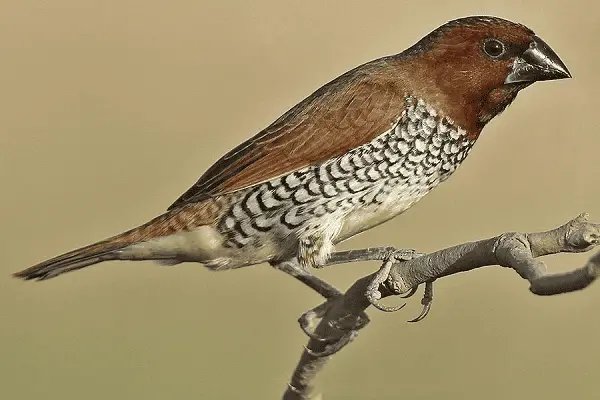
These birds are social and often build their nests in dense vegetation. Munias are known for their strong pair bonds and are often observed caring for their young together. Their adaptability to various habitats makes them a common sight in many regions.
6. Myna (Acridotheres spp.)
- Size: 9-12 inches (23-30 cm)
- Weight: 6-12 oz (170-340 g)
- Lifespan: 4-12 years in the wild
- Diet: Insects, fruits, and scraps of food
Mynas are medium-sized birds known for their striking yellow eye patches and loud calls. Native to South Asia, they have spread to many other regions, including urban areas where they thrive. Mynas are often seen scavenging for food, making them familiar sights in parks and streets.
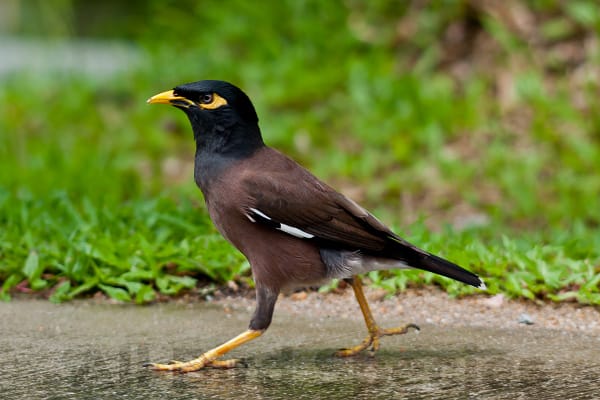
These birds are intelligent and can learn to mimic human speech and other sounds. They are social creatures that often live in pairs or small groups. Their adaptability to human environments has made them successful in many areas.
7. Martin (Progne spp.)
- Size: 5-8 inches (13-20 cm)
- Weight: 0.7-1.5 oz (20-40 g)
- Lifespan: 4-5 years in the wild
- Diet: Insects, particularly flying insects
Martins are small swallows known for their graceful flight and bluish-purple plumage. They often see soaring high in the sky, catching insects on their wings. These birds are social and usually nest in colonies, often under eaves or in specially designed birdhouses.

Martins are excellent fliers, able to cover great distances in search of food. Their insectivorous diet helps control pest populations, making them beneficial to agriculture. Their cheerful presence and aerial acrobatics delight birdwatchers and outdoor enthusiasts.
8. Magpie-Lark (Grallina cyanoleuca)
- Size: 11-14 inches (28-36 cm)
- Weight: 6.5-12 oz (180-340 g)
- Lifespan: 10-15 years in the wild
- Diet: Insects, worms, and small invertebrates
The Magpie-Lark, also known as the Peewee, is a striking black and white bird commonly found in Australia and parts of New Guinea. These birds are often seen near water sources, where they hunt for insects and worms. Their distinctive call is a familiar sound in their habitats.

Magpie larks are known for their bold behavior and inquisitive nature. They often forage in pairs or small groups, using their sharp eyesight to locate prey. Their adaptability and charming presence make them a favorite among birdwatchers.
9. Muscovy Duck (Cairina moschata)
- Size: 20-30 inches (51-76 cm)
- Weight: 6.5-15 lbs (3-7 kg)
- Lifespan: 8-12 years in the wild
- Diet: Omnivorous; plants, insects, and small fish
The Muscovy Duck is a large, distinctive duck native to Central and South America. They are known for their unique appearance, featuring a red facial caruncle and dark plumage. These ducks are often seen near water sources, where they forage for food.

Muscovy Ducks are omnivorous and have a varied diet, including plants, insects, and small fish. They are excellent foragers and often feed on the ground. Their friendly nature and adaptability to different environments make them popular as backyard poultry in many areas.
10. Mallard (Anas platyrhynchos)
- Size: 20-26 inches (51-66 cm)
- Weight: 2-3.5 lbs (0.9-1.6 kg)
- Lifespan: 5-10 years in the wild
- Diet: Omnivorous; aquatic plants, insects, and small fish
The Mallard is one of the most recognizable ducks in the world, known for its vibrant green head and distinctive quack. These ducks are commonly found in ponds, lakes, and rivers throughout Pennsylvania and beyond. They are social birds that often gather in large flocks.

Mallards are omnivorous and feed on various food, including aquatic plants, insects, and small fish. They are dabbling ducks, which means they feed primarily on the water’s surface or by tipping forward. Their adaptability and widespread presence make them a favorite among birdwatchers.
11. Masked Booby (Sula dactylatra)
- Size: 26-32 inches (66-81 cm)
- Weight: 2-4 lbs (0.9-1.8 kg)
- Lifespan: 10-15 years in the wild
- Diet: Fish and squid
The Masked Booby is a large seabird known for its striking appearance, featuring a white body and a black cap on its head. These birds are often found nesting on remote islands and are excellent divers, capable of plunging into the ocean to catch fish and squid.
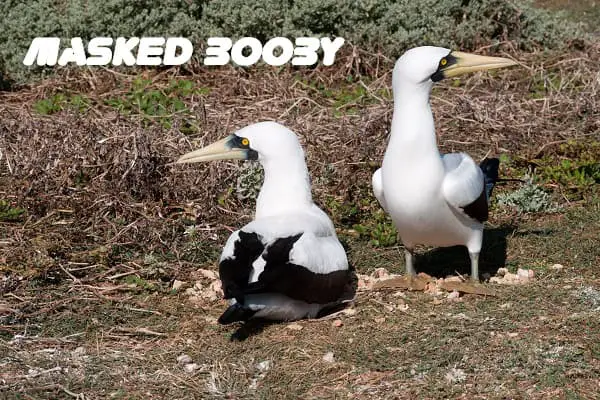
Masked Boobies are social birds that often nest in colonies. They are known for their graceful flight and impressive diving skills. Their diet primarily consists of fish, and they rely on their keen eyesight to spot prey from the air.
12. Merlin (Falco columbarius)
- Size: 10-12 inches (25-30 cm)
- Weight: 5.5-12 oz (155-340 g)
- Lifespan: 5-10 years in the wild
- Diet: Small birds, particularly songbirds
The Merlin is a small but fierce falcon known for its speed and agility. These birds are often found in open areas, such as fields and coastal regions, where they hunt small birds. Their dark plumage and sharp eyes make them skilled predators.

Merlins are known for their impressive aerial hunting techniques, often diving at high speeds to catch their prey. They are solitary hunters, and their diet primarily consists of small songbirds. Observing a Merlin in action is a thrilling experience for birdwatchers.
13. Mountain Bluebird (Sialia currucoides)
- Size: 6.5-8 inches (16-20 cm)
- Weight: 1-1.5 oz (28-43 g)
- Lifespan: 2-6 years in the wild
- Diet: Insects and berries
The Mountain Bluebird is a small songbird known for its vibrant blue plumage. These birds are often found in open habitats, such as grasslands and mountainous areas. Their cheerful songs and striking color make them a favorite among birdwatchers.

Mountain Bluebirds primarily feed on insects and berries, using their sharp eyesight to spot food from the ground or while flying. They are known for their beautiful courtship displays and often nest in cavities or old woodpecker holes.
14. Manakin (Pipridae spp.)
- Size: 3-5 inches (8-13 cm)
- Weight: 0.5-1 oz (15-30 g)
- Lifespan: 4-5 years in the wild
- Diet: Fruits and insects
Manakins are small, colorful birds found in the tropical forests of Central and South America. They are known for their vibrant plumage and unique courtship displays, which often include elaborate dances and vocalizations. Their bright colors and fascinating behaviors make them a favorite among birdwatchers.

These birds primarily feed on fruits and insects, often foraging in the forest’s understory. Manakins are known for short, quick flights and often use perches to survey their surroundings. Their unique mating rituals and vibrant colors add to the diversity of avian life.
15. Marabou Stork (Leptoptilos crumenifer)
- Size: 36-60 inches (91-152 cm)
- Weight: 4-20 lbs (1.8-9 kg)
- Lifespan: 25 years in the wild
- Diet: Carrion, fish, and small animals
The Marabou Stork is a large wading bird known for its distinctive bald head and long legs. Native to Africa, they are often found near wetlands and open fields, where they scavenge for food. Their imposing size and unusual appearance make them easily recognizable.

Marabou Storks are scavengers, feeding on carrion and hunting small animals and fish. They are known for their patience, often waiting for other animals to leave behind scraps. Their presence is vital for maintaining the ecological balance in their habitats.
16. Mistle Thrush (Turdus viscivorus)
- Size: 10-12 inches (25-30 cm)
- Weight: 2.5-4.5 oz (70-130 g)
- Lifespan: 3-5 years in the wild
- Diet: Fruits, insects, and worms
The Mistle Thrush is a medium-sized thrush known for its distinctive song and spotted breast. These birds, which start with the letter M, are often found in woodlands and gardens, where they forage for fruits and insects. Their melodious calls can be heard in the spring and summer months.
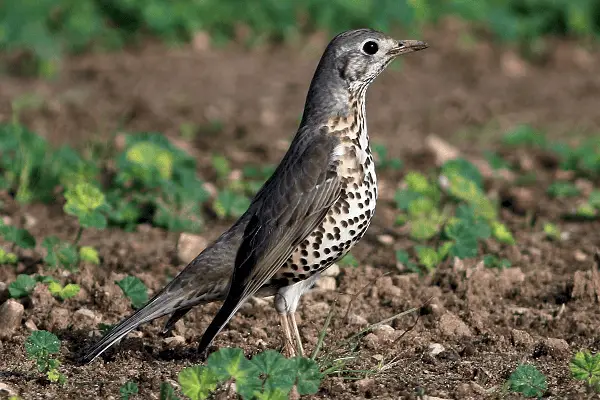
Mistle Thrushes are known for their strong territorial behavior, often singing from high perches to defend their nesting areas. Their varied diet allows them to adapt to different environments, making them a common sight in many regions.
17. Mockingbird (Mimus polyglottos)
- Size: 8-10 inches (20-25 cm)
- Weight: 1-2 oz (28-57 g)
- Lifespan: 3-5 years in the wild
- Diet: Insects, fruits, and berries
The Mockingbird is famous for its ability to mimic the songs of other birds and even sounds from its environment. These birds are widely distributed across North America and are often found in gardens and parks. Their melodious songs and playful behavior make them a delight to observe.
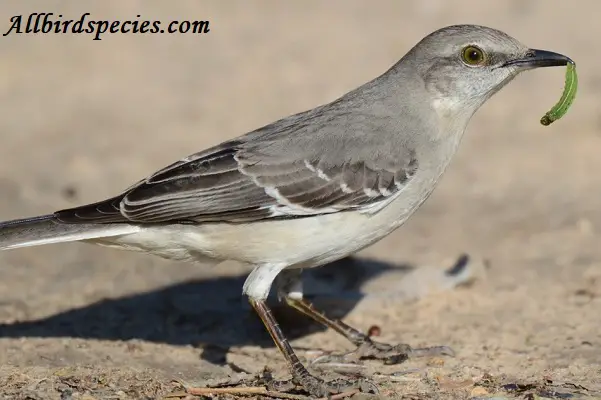
Mockingbirds are primarily insectivorous but will also eat fruits and berries. They are known for their aggressive behavior when defending their territory, often chasing off other birds. Their vocal talents and adaptability to different habitats make them a beloved species among birdwatchers.
Read More🐦Related Articles:
- Spiritual Meaning of a Bird Building
- Baby Birds Spiritual Meaning
- Eagle Eggs: Fascinating Facts About Raptor Nests
- Small Brown Birds In Florida
- What Do Ducks Eat
Conclusion
Birds that start with the letter “M” showcase various adaptations and behaviors. From the colorful Macaw to the melodious Mockingbird, these species enrich our environments and ecosystems. Understanding their characteristics, diets, and habitats allows us to appreciate the diverse avian life around us. Whether you are a birdwatcher or simply enjoy observing nature, these fascinating birds will surely capture your interest.

